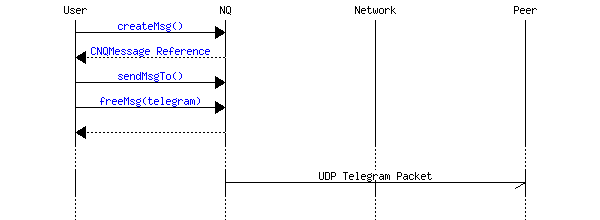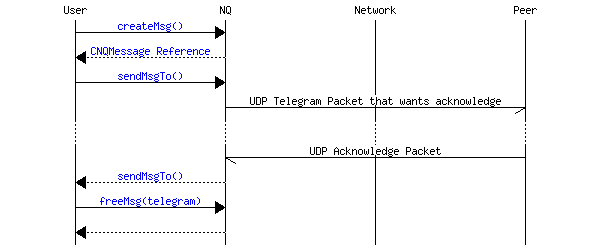Code Examples
CNQMessage reference pointer usage
This is an example of issuing an RPC-like call. It shows how to handle CNQMessage reference pointer, CNetworkQueue::create(), CNetworkQueue::freeMsg() and CNetworkQueue::sendRecvMsg().Communication Scheme

Example Code of RPC-call
#include "NQ.h" CNetworkQueue nq; // Initialisation of nq omitted ... bool ret; // helper variable for return values CNQMessage *request, *response; // Declare CNQMessage Pointers NQ_TIMEVAL timeout; // set timeout of one second timeout.tv_sec = 1; timeout.tv_usec = 0; request = nq.createMsg(); // request a new CNQMessage object reference if (request != NULL) { // configure packet type and fill with parameters request->setType(NQ_PT_REQUEST, NQ_LT_CALL); ... // call CNetworkQueue:sendRecvMsg() ret = nq.sendRecvMsg(&response, request, ip_hostorder_peer, port_hostorder_peer, timeout); if (ret==true) { // success! now handle with response CNQMessage ... // cleanup. free the CNQMessage reference, because we don't need it anymore nq.freeMsg(response); } else { // ERROR: CNetworkQueue:sendRecvMsg() returned error // now, handle the error ... // NOTE: we don't need to free response reference here, because it was not allocated } // free request reference, because we don't need it anymore nq.freeMsg(request); } else { // ERROR: CNetworkQueue::createMsg() did not return a valid CNQMessage reference pointer // now, handle the Error ... }
Asynchronous sending
This is an example of quickly pushing out (asynchronous, without blocking) a telegram message. It uses CNetworkQueue::sendMsg() without timeout.Communication Scheme

Example Code of asynchronous sending
#include "NQ.h" CNetworkQueue nq; // Initialisation of nq omitted ... bool ret; // helper variable for return values CNQMessage *telegram; // Declare CNQMessage Pointer telegram = nq.createMsg(); // request a new CNQMessage object reference if (telegram != NULL) { // configure packet type and fill with parameters telegram->setType(NQ_PT_REQUEST, NQ_LT_CALL); ... // call CNetworkQueue:sendMsgTo() ret = nq.sendMsgTo(telegram, ip_hostorder_peer, port_hostorder_peer ); if (ret==true) { // success! message should be sent out and received at remote peer // however, there is no guarantee! ... } else { // ERROR: CNetworkQueue:sendMsgTo() returned error // now, handle the error ... } // free request reference, because we don't need it anymore nq.freeMsg(telegram); } else { // ERROR: CNetworkQueue::createMsg() did not return a valid CNQMessage reference pointer // now, handle the Error ... }
Synchronous sending
This is an example of sending-with-acknowledge (synchronous, timeout blocking) a telegram message. It uses CNetworkQueue::sendMsg() with timeout.Communication Scheme

Example Code of synchronous sending
#include "NQ.h" CNetworkQueue nq; // Initialisation of nq omitted ... bool ret; // helper variable for return values CNQMessage *telegram; // Declare CNQMessage Pointer NQ_TIMEVAL timeout; // set timeout of one second timeout.tv_sec = 1; timeout.tv_usec = 0; telegram = nq.createMsg(); // request a new CNQMessage object reference if (telegram != NULL) { // configure packet type and fill with parameters telegram->setType(NQ_PT_TELEGRAM, NQ_LT_UPDATE); ... // call CNetworkQueue:sendMsgTo() ret = nq.sendMsgTo(telegram, ip_hostorder_peer, port_hostorder_peer, timeout ); if (ret==true) { // success! message should be sent out and received at remote peer // this is guaranteed! ... } else { // ERROR: CNetworkQueue:sendRecvMsg() returned error // now, handle the error ... // NOTE: this does not mean that the message was not received at remote peer, it could // also be that the acknowledge packet ("got it") did not properly arrive (in-time) at local peer } // free request reference, because we don't need it anymore nq.freeMsg(telegram); } else { // ERROR: CNetworkQueue::createMsg() did not return a valid CNQMessage reference pointer // now, handle the Error ... }
Receiving Loop
This is an example of a receiving loop. It shows how to handle CNQMessage reference pointer, CNQMessage::getSenderIPandPort(), CNetworkQueue::freeMsg() and CNetworkQueue::recvMsg() with timeout.Communication Scheme

Example Code of receiving loop
#include "NQ.h" CNetworkQueue nq; // Initialisation of nq omitted ... bool ret, ret2; // helper variable for return values CNQMessage *inMessage; // Declare CNQMessage Pointer bool bShutdown = false; NQ_TIMEVAL timeout; // set timeout of one second timeout.tv_sec = 1; timeout.tv_usec = 0; while( !bShutdown ) { ret = nq.recvMsg(&inMessage, timeout); if (ret == true) { UINT32 ipHostorderPeer, portHostorderPeer; // a packet was received from (any registered) remote peer // NOW: check where it came from, what are the contents and do something about it ret2 = inMessage->getSenderIPandPort(ipHostorderPeer, portHostorderPeer) if (ret2 == true) { // compare ipHostorderPeer and portHostorderPeer if necessary // HERE: read out type and contents of packet, branch and react accordingly } // IMPORTANT: do not forget to put back CNQMessage instance after no longer needing it nq.freeMsg(inMessage); // DONT FORGET: any access to inMessage is invalid afterwards! } }
 1.5.5
1.5.5